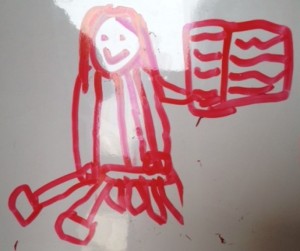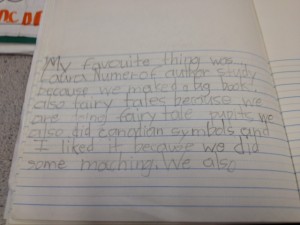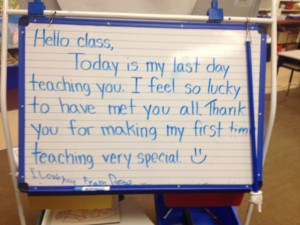 I had an incredibly transformational practicum experience. It was ten weeks of laughter and learning experiences that I honestly did not want to come to an end.
I had an incredibly transformational practicum experience. It was ten weeks of laughter and learning experiences that I honestly did not want to come to an end.
I have made a brief description of each unit I had the pleasure of creating and putting into action with the students within this section and below is some of the reflections I wrote about throughout this experience. The practicum reflections are a bit disjointed but I feel really show the insights gained from this reflective process.


Practicum Reflections
Week 1
- I will probably not use everything I have prepared for, and that’s okay!
-So far in this week I have used about two thirds of the morning meeting materials I planned on using and changed around my Canadian symbols unit by quite a bit. I was warned that this would happen. This week of putting my lesson plans into action has really given me a feel for what is practical to accomplish and what might take more time than I had at first anticipated. This reminds me to always keep in mind the purpose of the lesson and the overall unit when deciding what to cut and what to keep.
-What my school advisor has really shown me over and over again is that our aim is to set up our students for success. The more I interact with the students the better I get at anticipating what learning expectations are realistic. For me this is great because it makes lesson planning a lot easier!
Week 2
-Being flexible can be difficult when you have a lot of exciting materials to share with your students but at the end of the day it’s better to go deep with things that are most important then rushing just to get to everything.
- When in doubt, talk to your school advisor.
-I had created a one hour lesson plan on beavers (in relation to the Canadian Symbols Unit). I was a little unsure of how it would go because I had yet to do a craft project with the students. After explaining to my school advisor what I planned on teaching she soon pointed out that learning about the subject, in this case beavers in relation to Canadian symbols, should be broken up throughout the week instead of just one long lesson. By breaking up this lesson into smaller chunks over a four day period really allowed for us to go deep with their learning. By the end of the week when we actually put together our beaver craft students were engaged because they had knowledge about beavers. They loved showing me how they had remembered the facts we had learnt over the last few days and the craft went extremely well. Thank you SA!
Week 3
–Introductions and conclusions really matter. When creating detailed lesson plans for my own classes at UBC I always felt a little lost at what exactly my professors were looking for in a lessons introduction and conclusion. Introducing and lesson and closing it up to me felt a bit redundant on paper. However now that I am in the classroom on a daily basis I can see how wrong I was. The value in introducing and concluding a lesson is not only to emphasize the take away message of the lesson overall but I’ve found that it also is valuable for classroom management. By introducing a lesson I am giving the students an expectation of what is to come thus preparing them so they can be successful. By concluding a lesson I am bringing the students focus back on me. This is often needed because the students are often completing work at different times and the energy within the classroom can be quite high by the end of a lesson. This allows for a smooth transition onto the next activity planned!
Week 4
-For me classroom management is something that I am constantly aware of and eager to receive feedback on from my faculty advisor and school advisor. One suggestion my faulty advisor gave me that really want to implement is a good news letter when some of the individual students who have difficulty self-managing throughout the day have a successful day. Although the expectation is that all students follow the classroom rules – some students who have some difficulty doing so need extra encouragement and praise when they do follow the rules instead of just acknowledging when they have had a tough day. In my former job as a behavioural interventionist consistent positive reinforcement was so important to the success of the child and I can see the benefits it has in the classroom as well. I am going to try it and let the students know “You’ve done so well today I want your mom and dad to know how impressed I was so I wrote them a quick note and put it in your planner”. I am very eager to see how the students respond to this!
- The value of observational assessment – In math we are doing a unit on non-standard measurement. I found it difficult to assess students based on the work they were submitting because answers varied depending on what they were measuring and unit they measured with. I felt this unit would be a good opportunity to do some one-on-one individual assessment. During centers and iPad time asked each child to pick the best unit (out of three) to measure a piece of paper. I was looking for five things in particular. One, that they knew the best unit to pick was the popsicle stick because it was longest item. Two, that they knew that the popsicle stick was their unit and the paper was the object they were measuring. Three, that they could make a somewhat accurate estimate of how many popsicle sticks it would take to get across the paper. Four, that they measured correctly by putting the stick down, putting their finger done to hold its place and then picked up the stick and put it on the other end of their finger. And five, that they can articulate their answer. This assessment took approximately 30 seconds to a minute per child and was more informative to me about the students understand of measuring more than any worksheet they had submitted.This really taught me the value of observational assessment especially in the primary grades when students reading and writing abilities vary greatly.
Week 5
- Planning partner work. I see such value in partnering students up so they can work together and learn from one another. I try to partner students up wisely based on their individual strengths. However a lot of the time when I gave them partner work they would do very little communicating and would complete the activity individually. Both my school advisor and faculty advisor mentioned some suggestions for partner work that has been working well since implemented. First, only giving them one set of materials (worksheet etc.) so that they cannot finish at separate times and need to be in close proximity of each other. Second, giving specific tasks for each partner so that both are required to contribute. I have taken these suggestions and used it for their worm fact books and it worked out a lot better!
Week 6
- Letting them get their sillies out! This was advice straight from my faculty advisor. In one math lesson I had students using pipe cleaners to measure different paths on their worksheet. My class loves hands-on activities however I underestimated how distracting the pipe cleaners would be for them. It is completely normal for kids to want to play with new materials they are given, (especially fuzzy bendy things!) however I had to be quite firm with the class about my expectations for how they could use the materials. My faculty advisor gave me a great suggestion for how to combat new possibly distracting materials. She simply told me to give them a few minutes when the materials are first given out to ‘get their sillies out’. The suggestion is simple but it makes complete sense and I am taking this advice to heart for hands-on activities coming up!
Week 7
-Being in the gym is very different from the classroom! So far in P.E I have been doing a lot of games and sports that the students are already quite familiar with (other than badminton). However when I introduced new games for our cooperative games unit I seen first hand how different a gym environment is for instruction time than the classroom. Management strategies that worked for the classroom seemed a lot less effective in the gym (boundaries are definitely being tested!) and I noticed my voice (that often projects quite well) was draining out quite easily. I have to say I am very fortunate to have received so much helpful feedback from my faculty and school advisors concerning this. Talking less is more effective in the gym. Using the whistle when needed and really waiting for everyone to be quiet before delivering instruction is so important. I am still in the process of learning what works and what doesn’t in the gym!
Week 8
–Student-centered learning. Also as I am looking ahead as to what is most valuable to teach in the 3 weeks I have left (because I’ve faced the fact that I will not be able to cover everything I had planned) I decided to think back to my biggest successes (and challenges) over the last seven weeks. I want to really make the last 3 weeks as successful as I can and I have really come to realize that I am most successful when I deeply consider the students interests and what motivates them (and incorporate as much as that into the lessons as possible). Stations and cooperative work has proved to work well with this group of students and their imagination and sense of creativity is so evident in everything they do. With this in mind I have decided that I will definitely continue forward with my community unit stations and creating fairy tale puppets. I decided against starting my light and sound unit but will give my unit plan to my school advisor so hopefully she can use it with the students when I am no longer there!
Week 9
–Relationships matter. (this sounds quite obvious, but let me explain!). For my professional day I had the opportunity to attend a workshop on Classroom Management for TTOC’s. I have to say I am so fortunate to have signed up for this particular workshop. Not only did it apply to what I’ll (hopefully) be doing in September but it also allowed me a chance to interact with other teacher candidates and TOC’s. I learnt a bunch of useful strategies within the workshop itself but I also learnt from TOC’s themselves. So far the most valuable information I’ve received have been from fellow teachers. I feel so grateful to be surrounded by a community of professionals that are eager to provide useful advice and that are interested in collaboration (this is exactly what I wanted out of a profession!). It truly speaks volumes to the value of building relationships with fellow colleagues (whether it be just keeping in touch or being able to collaborate on unit planning or classroom management strategies).
Week 10
–As an educator, you’re a life-long learner. As I near the end of my practicum I often reflect back to how much I have learnt in ten weeks at this school. It’s been the most beneficial life experience as I start my career as an educator however it is also really exciting to think ahead at the experience/knowledge/skills I’ll continue to gain as I head back to UBC, attend the last of my classes, read more books, do my community field experience, and become a TOC. And that’s just in the near future, I know their will be plenty more to come further down the road. It dawned on me that this was my life now, full of learning opportunities, reflection, and growth – how lucky am I?
